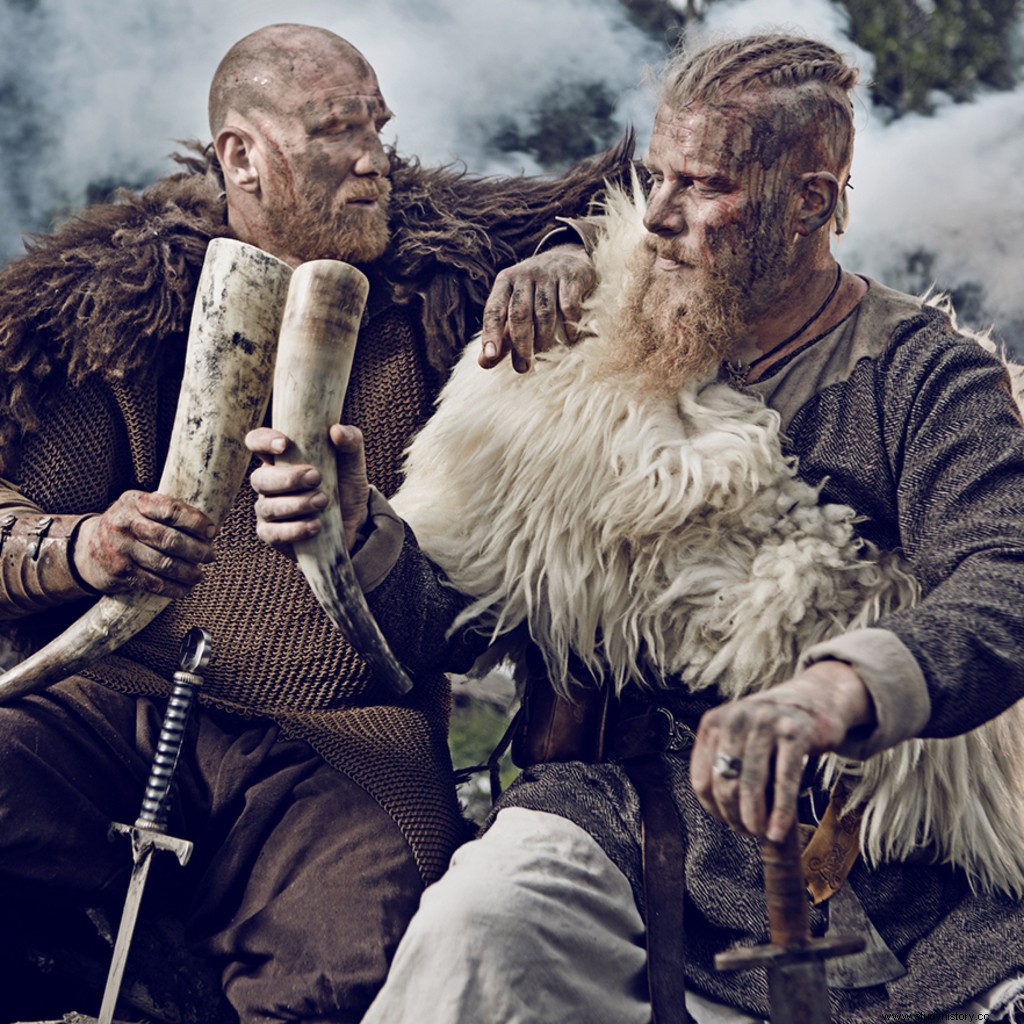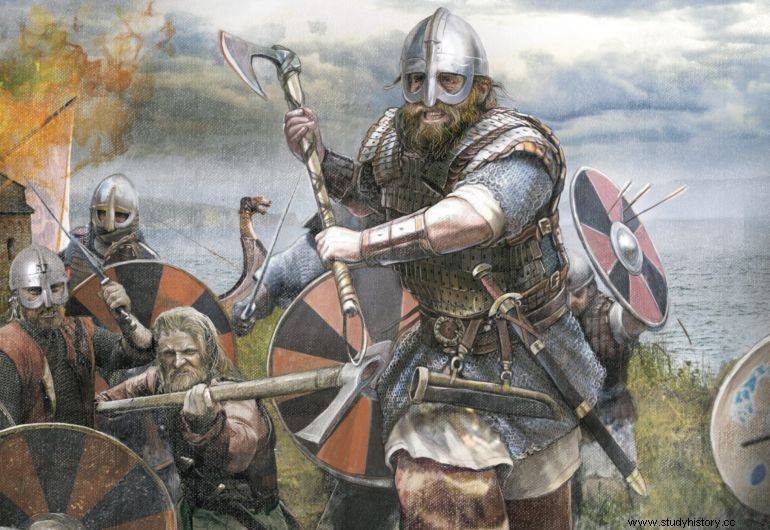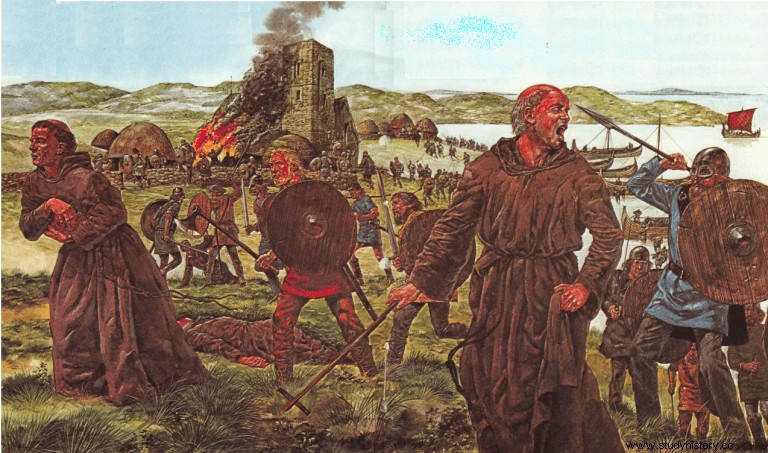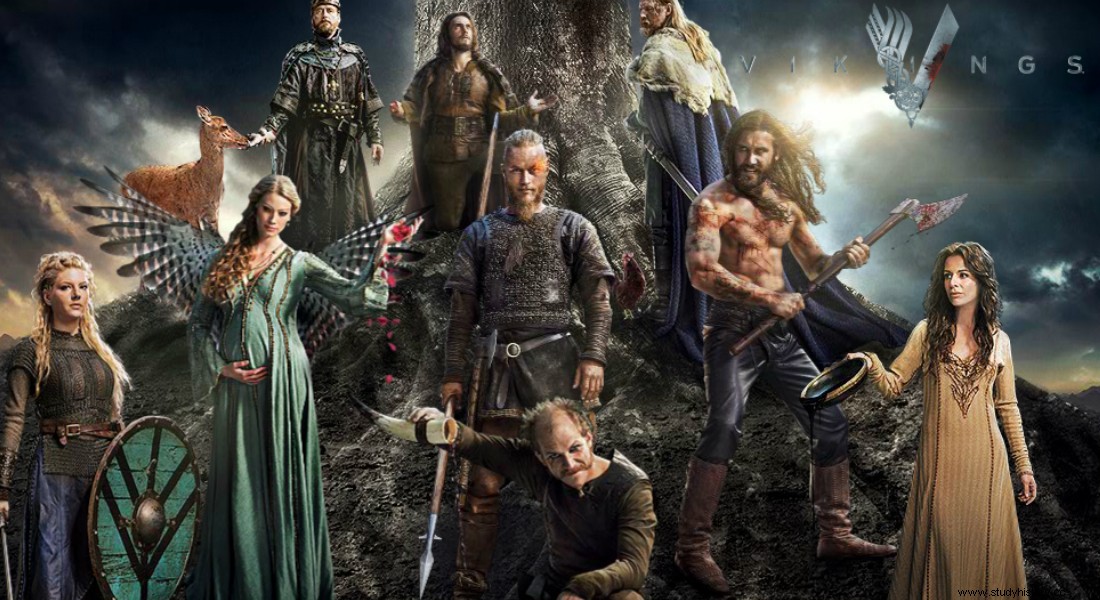The Church is bathed in the blood of the priests of God, orphaned of all objects and exposed to the plunder of the pagans. From the fury of the Norse, deliver us, Lord.
With texts of this style it is logical to think that the reputation of these Nordics has been very touched and their legacy has been that of brutal, bloodthirsty and looters. Of course, nothing strange, if the origin of these texts have been the monks who suffered in their flesh the assaults and the Eddas and Sagas that were written when these peoples had already been Christianized and had abandoned their pagan gods. So, maybe the lion is not as fierce as they paint it, and surely they did not wear helmets with horns, which must have been added to give them a more demonic touch. The horns, from all Odin's life, were used for calls to war and for beer or mead in his celebrations, where he drinks as if there were no tomorrow and Obelix-style boar is served. Possibly, these containers have something to do with their fame as drunkards. And I explain. Given their shape and given the impossibility of leaving them supported, for example when you are lucky enough to be asked to dance by a beautiful Ingrid, they were drank them down in one drink.

Logically, these Nordics I am talking about were none other than the (badly) called Vikings. And I say misnamed because the Viking is not born, he is made . You are not a Viking, you exercise Viking activity. When these Nordic peoples went on an expedition, whether it be trade, exploration or pillage, they played Viking or, to make it sound better, they acted as Vikings. Those who stayed in Scandinavia working their land, fishing and tending their cattle, were not. In fact, for those who suffered these expeditions they were not Vikings either, they were usually called by their origin:Danes, Norwegians or Swedes (Varegians in Eastern Europe).
The image that has remained etched in the popular imagination of these demons from the north is that of those medieval Europeans who saw long, narrow ships arrive at their shores and tall, blond, tattooed men armed with axes disembarked from them. and knives to dismember the bodies, and that, in the blink of an eye, destroyed everything and disappeared. That they also did it (they went looting to obtain loot), but we must not forget that they were great explorers and merchants, between the end of the 8th and the 11th centuries, they reached the Black Sea, the Slavic coasts, England, Scotland, the Mediterranean, Constantinople, besieged Paris, up the Seine, and even sacked Seville during a quick foray across the Guadalquivir River. They created dukedoms, the kingdom of Sicily, the Rus of kyiv (the germ of Russia), they explored and founded permanent settlements in Iceland or Greenland, and others that they abandoned, such as Newfoundland (present-day Canada). Yes, yes... they arrived on the American continent almost 500 years before Columbus, although they were unable to establish a permanent colony due to certain problems of coexistence with the indigenous people.

Regardless of why they left their native Scandinavia, their success was based on their expert seamanship and their warships, the famous drakkars. . By the way, named after centuries after the dragon-shaped masks that some wore. They were long, narrow boats, with an almost flat keel and a shallow draft (the submerged part), which allowed them to navigate both in the sea and in rivers. Although they had a removable mast and a square sail to take advantage of the wind, the key to their precise maneuverability was provided by the warriors in their work as oarsmen, a light hull that weighed little, and the fact that the bow and stern used to have the same. , and thus to go around the oarsmen only had to turn. A rudder and nothing else, practical ships without artifice. And if necessary, for example to overcome obstacles, avoid rapids or reach the next river, they would strip the mast and transport the boat by land.
We're going on a rampage
We headed west, for example, to England and reached the British coast. We disembark and, to our surprise, we find a monastery from which a monk emerges, wielding as his only weapon a crucifix that he holds in front of him in his left hand and with his right hand points to the sky. We look up to see if there is any threat hanging over our heads and not a damn cloud, so we put our eyes back on that crucifix which, by the way, is gold inlaid with precious stones. Ax to the arm or head and crucifix to the bag. The rest of the monks run like headless chickens and take refuge inside the main building. Those wooden doors are not prepared to support the Vikings in search of loot. Upon entering, we find several monks kneeling and directing their prayers to the figure of a crucified man. That it seems that he is his God, or one of the three they have, but at the same time they are only one. Well, a ruckus. Other monks tried to hide everything that glitters, but to no avail. So, as the chronicle of the beginning said “The Church is bathed in the blood of the priests of God, orphaned of all objects and exposed to the plunder of the pagans ”. It didn't do them any good either that we took some boxes they called lockets and emptied them out to give to our wives as jewelry boxes, or ripped the jeweled covers off their books. But who would think of leaving all these valuables without any protection! If they are causing Later, we learned that those monasteries or temples of their God were sacred and no Christian would have dared to profane them. It is clear that they did not think of the pagans of the north.

Were they so cruel?
Let's go by parts. We are talking about pillaging raids involving a few ships with around 50 warriors per longship, so the success of the mission was all about surprise and speed. For example, imagine that our objective is to loot a monastery and someone has given the alarm signal The Vikings are coming! It would give the monks time to hide or bury the treasures and it is a chore, because I assure you that we can now consider it lost. Even if you subject them to the most atrocious tortures, they don't let go. We couldn't mount a siege or engage in big battles with people in arms. A siege supposes, in addition to having a very important number of Vikings, a very vulnerable situation and, therefore, not desirable. Logically, we also couldn't leave survivors who could warn other locations and destroy the element of surprise.

So, yes, we were somewhat cruel (it seems to me that I have fully immersed myself in the role), but those who were in charge of recounting our deeds also added a lot of their harvest. Cutting your enemy has always been easy, yours will be willing to believe everything, but criticize until we wash every day and bathe once a week. Come on… The truth is that, when the time came, we decided to take advantage of that marketing campaign and take advantage of our black legend and increase it if possible. In this way, our bad publicity made us more fearsome in order to loot other places more easily.
